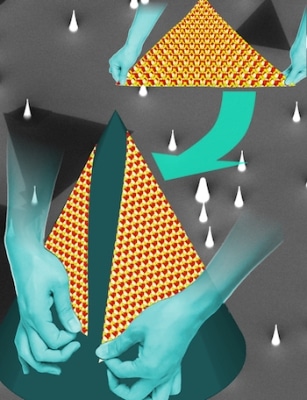Aug 10 2017
Researchers from Rice University have discovered a way to manipulate 2D materials to design in defects that improve the materials’ properties.
 Two-dimensional materials grown onto a cone allow control over where defects called grain boundaries appear. These defects can be used to enhance the materials’ useful properties. (Courtesy of the Yakobson Research Group)
Two-dimensional materials grown onto a cone allow control over where defects called grain boundaries appear. These defects can be used to enhance the materials’ useful properties. (Courtesy of the Yakobson Research Group)
The Rice lab of Theoretical Physicist Boris Yakobson and colleagues at Oak Ridge National Laboratory are merging theory and experimentation to demonstrate it is possible to give 2D materials particular defects, especially atomic-scale seams known as grain boundaries. These boundaries may be used to improve the materials’ electronic, optical, mechanical, magnetic and catalytic properties.
The idea is to introduce a curvature to the landscape that coerces the way defects propagate. The Researchers refer to this as “tilt grain boundary topology,” and they accomplish it by growing their materials on a topographically curved substrate — in this case, a cone. The angle of the cone dictates what type and where the boundaries appear.
The research paper has been published in the American Chemical Society journal ACS Nano.
Grain boundaries are the borders that form in a material where edges meet in a mismatch. These boundaries are a series of defects; for instance, when two sheets of hexagonal graphene meet at an angle, the carbon atoms make up for it by forming non-hexagonal (five or seven member) rings.
Yakobson and his team have already shown that these boundaries can be electronically substantial. They can, for example, convert flawlessly conducting graphene into a semiconductor. In certain cases, the boundary itself may be a conductive sub-nanoscale wire or adopt magnetic properties.
But so far Researchers had limited control over where those boundaries would show up when growing molybdenum disulfide, graphene or other 2D materials by chemical vapor deposition.
The theory developed at Rice revealed growing 2D material on a cone would coerce the boundaries to appear in specific places. The cone’s width controlled the placement and, more significantly, the tilt angle, an important parameter in tweaking the materials’ magnetic and electronic properties, Yakobson said.
Experimental partners from Oak Ridge led by Co-author David Geohegan provided evidence backing main aspects of the theory. They accomplished this by growing tungsten disulfide onto small cones just like those in Rice’s computer models. The boundaries that appeared in the real materials corresponded to those predicted by theory.
The nonplanar shape of the substrate forces the 2D crystal to grow in a curved ‘non-Euclidian’ space. This strains the crystal, which occasionally yields by giving a way to the seams, or grain boundaries. It’s no different from the way a tailor would add a seam to a suit or a dress to fit a curvy customer.
Boris Yakobson, Theoretical Physicist, Rice University
Modeling cones of varying widths also revealed a “magic cone” of 38.9 degrees upon which growing a 2D material would not leave any grain boundary at all.
The Rice team broadened its theory to see what would take place if the cones were placed on a plane. They predicted how grain boundaries would develop over the whole surface, and again, Oak Ridge experiments proved their results.
Yakobson said both the Rice and Oak Ridge teams were working on aspects of the research individually.
It was slow going until we met at a conference in Florida a couple of years back and realized that we should continue together. It was certainly gratifying to see how experiments confirmed the models, while sometimes offering important surprises. Now we need to do the additional work to comprehend them as well.
Boris Yakobson, Theoretical Physicist, Rice University
Rice Graduate Students Henry Yu and Nitant Gupta are the paper’s Co-lead Authors. Co-authors are former Rice Postdoctoral Researcher Zhili Hu, now at Nanjing University of Aeronautics and Astronautics, and Researchers Kai Wang, Bernadeta Srijanto and Kai Xiao of Oak Ridge National Laboratory. Geohegan is the functional hybrid nanomaterials group leader at Oak Ridge’s Center for Nanophase Materials Sciences. Yakobson is the Karl F. Hasselmann Professor of Materials Science and NanoEngineering and a Professor of Chemistry.
The U.S. Department of Energy Basic Energy Sciences and its Center for Nanophase Materials Sciences and the Office of Naval Research supported the research.
Computer resources were supplied by the Night Owls Time-Sharing Service and its National Science Foundation-supported DAVinCI supercomputer, both administered by Rice’s Center for Research Computing; the resources were procured in collaboration with Rice’s Ken Kennedy Institute for Information Technology.